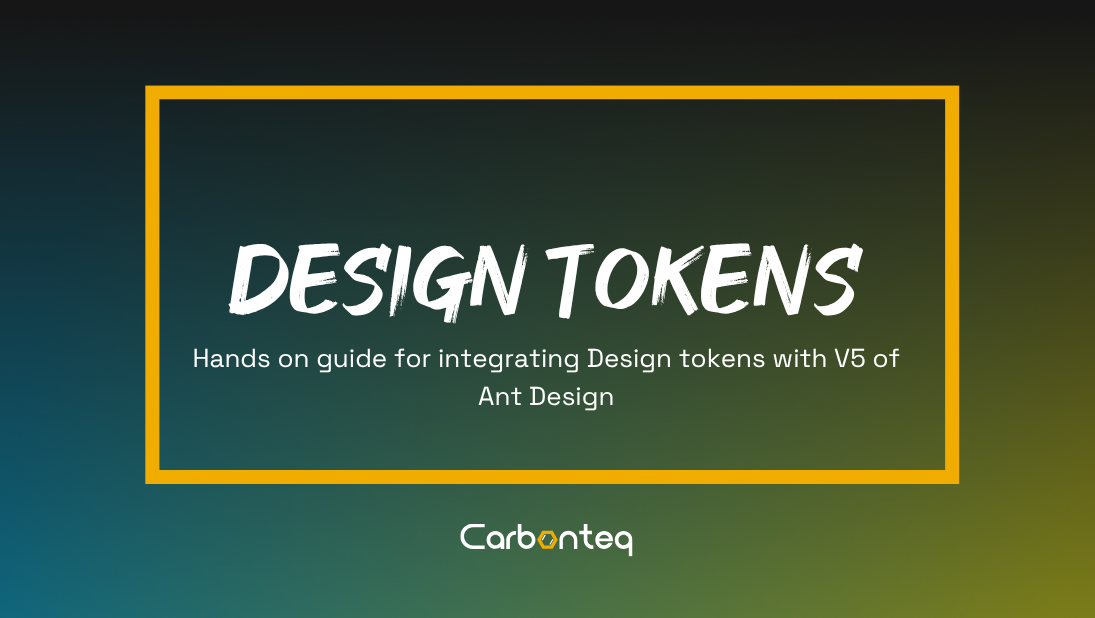AntD Design Tokens 101: Simplifying UI Design for Everyone
An overview of Design Tokens and their Integration with the newly released version 5 of Ant Design.

In this article, we will be discussing the Design Tokens and their Integration with the newly released version 5 of Ant Design.
Design Tokens are generally all the values needed to construct and maintain a UI. Design tokens can include color, typography, spacing, etc. For example, if there is the color green specifically used by Starbucks, their designers will tokenize the hex value of that color e.g, starbucks_green. Now they can use this token in the whole UI design. In the future, if Starbucks wants to change the shade of their color green or even completely replace the color green, a designer can just change the value of the color starbucks_green token and it will reflect in the whole UI design.
Ant Design v5 has shifted from LESS variables to token system. Now they have a ConfigProvider component which can be paired with design tokens for styling purpose. They have launched a new paid product named Ant Design System for Figma. This product will be mainly used for generating and exporting tokens from Figma and integrating those tokens with Ant Design.
Here's a list of the concepts that will be covered in this blog:
- Setting up the integration mechanism of tokens with Figma using GitHub Actions
- Transforming tokens into format required by Ant Design
- Using transformed tokens in code.
- Overriding the styles provided by tokens.
- Understanding the pros, cons, and best practices to follow
You can find the complete code at:
https://github.com/muzzamilr/design-tokens-workshop
Let's code!
We will be using Vite for the React project setup, by using this command:
npm create vite
this command will prompt some options and you need to name the project, choose React as library and JavaScript as language. You can test if the project setup is correct by running command:
npm start dev
Dependencies
After creating the project, we need to install dependencies, which includes,
- Ant Design
- Figma Tokens Transformer
using this command:
npm install antd figma-tokens-transformer
Figma Token Transformer Config
Figma tokens transformer is a package that helps to transform the tokens exported from Figma into the format specified by Ant Design.
tokens-transformer.config.json
{
"version": 5,
"source": {
"tokensFile": "src/tokens/tokens.json"
},
"target": {
"jsonsDir": "src/ant-tokens"
}
}
This file lives in the root of the project and we need to specify the version of Ant Design we are using and the source of the tokens file exported by Figma and the target directory in which the transformed JSON files will be generated.
tokens-transformer.secret.json
This file will be created in the root of the project and it includes the license key and email of Ant For Figma.
Don't commit this file.
{
"license": {
"key": "Key",
"email": "email"
}
}
After completing this step configuration for Figma token transformer is complete
GitHub Workflows
Disclaimer: This step can be skipped because you can handle the tokens update manually.
We need to create GitHub actions for automating the workflow, whenever the designer exports from Figma to GitHub, these actions will transform and push the the new transformed tokens in the branch. Before all this make sure you setup git in your project using this command:
git init
.github/workflows/transform.yml
name: Tranform Tokens
on:
push:
paths:
- 'src/tokens/**'
branches:
- master
jobs:
transform_tokens:
runs-on: ubuntu-latest
steps:
- name: Checkout code
uses: actions/checkout@v3
with:
token: ${{ secrets.COMMIT_TOKEN }}
- name: Setup Node 18
uses: actions/setup-node@v3
with:
node-version: '18.x'
- run: npm ci
- run: LICENSE_KEY=${{ secrets.LICENSE_KEY }} LICENSE_EMAIL=${{ secrets.LICENSE_EMAIL }} npx figma-tokens-transformer transform
- name: Commit & Push changes
run: |
git config --global user.name <username>
git config --global user.email "[email protected]"
git add .
git commit -m "Generated new tokens"
git push
In this piece of code we are creating a job named tranform_tokens which runs on Ubuntu and sets up node v18. It installs the dependencies npm ci and then transformation command runs. After transformation it commits and pushes code to the branch.
You will need to setup the secrets for this repository in the settings of that repository, for the secrets setup you can follow this guide
https://docs.github.com/en/actions/security-guides/encrypted-secrets
Tokens Directory Setup
After setting up the GitHub actions, we need to create tokens directory in src directory and add the tokens.json file exported from the Figma Tokens Plugin.
Create a new directory in src directory named ant-tokens
After creating these directories and adding tokens.json file in the src/tokens directory we can run the transform command which will generate the light and dark json files in the target directory.
Run:
npx figma-tokens-transformer transform
After running this command you can see the json files created in the target directory ant-tokens
└── /src
├── /ant-tokens
├── light.json
├── dark.json
├── /tokens
├── tokens.json
├── App.jsx
├── button.jsx
├── child.jsx
├── main.jsx
├── styles.css
ANTD Project Setup
Now we will use different components of Ant Design for testing the tokens in ConFigProvider
src/App.jsx
import {
Button,
Select,
Radio,
Checkbox,
Input,
ConfigProvider,
Space,
Layout,
Switch,
Calendar,
} from "antd";
import { useState } from "react";
import * as lightTheme from "./ant-tokens/light.json";
import * as darkTheme from "./ant-tokens/dark.json";
import { ButtonMod } from "./button";
const App = () => {
const [dark, setDark] = useState(false);
const handleChecked = (checked) => {
if (checked) setDark(true);
else setDark(false);
};
return (
<ConfigProvider
theme={{
// algorithm: dark ? theme.darkAlgorithm : theme.lightAlgorithm,
token: dark ? darkTheme : lightTheme,
}}
>
<Layout
style={{
display: "flex",
alignItems: "center",
justifyContent: "center",
height: "100vh",
}}
>
<Space direction="vertical" size={10}>
<Switch
checkedChildren="Light"
unCheckedChildren="Dark"
onChange={handleChecked}
/>
<Button>Button</Button>
<ButtonMod />
<Checkbox>Checkbox</Checkbox>
<Radio>Radio</Radio>
<Select
placeholder="Select"
options={[{ label: "Select", value: "Option" }]}
/>
<Calendar fullscreen={false} style={{ width: "300px" }} />
<Input
prefix={
<MsgSvg
color={dark ? darkTheme.colorPrimary : lightTheme.colorPrimary}
/>
}
placeholder={"Input"}
/>
</Space>
</Layout>
</ConfigProvider>
);
};
const MsgSvg = ({ color }) => (
<svg
width="16"
height="16"
viewBox="0 0 16 16"
fill="none"
xmlns="http://www.w3.org/2000/svg"
>
<path
d="M11.9512 0C13.024 0 14.056 0.471111 14.8152 1.31644C15.5752 2.16 16 3.29778 16 4.48889V11.5111C16 13.9911 14.184 16 11.9512 16H4.048C1.8152 16 0 13.9911 0 11.5111V4.48889C0 2.00889 1.8072 0 4.048 0H11.9512ZM12.856 4.62222C12.688 4.61244 12.528 4.67556 12.4072 4.8L8.8 8C8.336 8.42756 7.6712 8.42756 7.2 8L3.6 4.8C3.3512 4.59556 3.0072 4.62222 2.8 4.86222C2.584 5.10222 2.56 5.48444 2.7432 5.75111L2.848 5.86667L6.488 9.02222C6.936 9.41333 7.4792 9.62667 8.048 9.62667C8.6152 9.62667 9.168 9.41333 9.6152 9.02222L13.224 5.81333L13.288 5.74222C13.4792 5.48444 13.4792 5.11111 13.2792 4.85333C13.168 4.72089 13.0152 4.64 12.856 4.62222Z"
fill={color}
/>
</svg>
);
export default App;
In the App.jsx file we have used different components like Button, Select, Radio, Checkbox, Input, Switch, Calendars and ConfigProvider for setting up the tokens.
We are using Switch Component for switching between dark and light mode. We have imported dark and light json files.
Wrapped the whole App component in the ConfigProvider and passed dark and light as tokens in the theme prop.
There is also a MsgSvg component used in the Input component as Prefix to change the color of according to theme we are reading the value of colorPrimary from dark and light json files.
P.S. Ant Design provides useToken hook for accessing all the tokens provided in the ConfigProvider. Here we are not using that hook because of Top to Bottom data flow of React that hook is not usable in this component but will be available in the child components e.g ButtonMod
src/button.jsx
import { Button, ConfigProvider, theme } from "antd";
import { Child } from "./child";
const { useToken } = theme;
export const ButtonMod = () => {
const { token } = useToken();
return (
<ConfigProvider
theme={{
inherit: false,
components: {
Button: {
// borderRadius: token.borderRadiusSM,
// colorPrimaryHover: token.colorPrimaryHover,
},
},
}}
>
<Button
size="middle"
style={{
borderRadius: token.borderRadiusXS,
color: token.colorPrimary,
}}
>
Button
</Button>
<Child />
</ConfigProvider>
);
};
In this code we have use ConfigProvider and passed false to the inherit property of theme prop. Now it will not inherit the theme and tokens from the previous ConfigProvider, we can also style specific components by providing the type of component in components property of the theme.
All tokens are overridable, for example if we are using black as primary color in the parent ConfigPovider, we can override it by wrapping in another ConfigProvider and passing values to it. If the inherit is true (true by default) then it will inherit all the previous properties and only override the provided properties in the child component.
Here we are using useTokens hook and these token values are inherited from the parent ConfigProvider even if the child ConfigProvider inherit is false.
We can also use tokens in in-line styles.
src/child.jsx
import { Button } from "antd";
export const Child = () => {
return <Button>Child</Button>;
};
In this code, we are just returning an Ant Button component. As you remember we passed false to inherit in its parent component and no token are defined in its parent ButtonMod component. So, this component will have the default styles of Ant Design.
Even if we try to call use useToken hook in this component, the token values provided by the hook will be the default values of Ant Design.
ANTD Additional Customization Details
You can also pass an algorithm into the theme object in the config provider, these algorithms take a seed token as a parameter and return map and alias tokens. Algorithms can be used for in-app accessibility options such as increasing the font size by a specific variable.
Here is an example of the above use case:
const [fontSizeIncrement, setFontSizeIncrement] = useState(0);
const increaseFontSize = (theme) => {
let MapTokens = theme;
const fontTokens = Object.keys(MapTokens).filter(token => token.includes("font"))
fontTokens.map(token => {MapTokens[token] = MapTokens[token] + fontSizeIncrement} )
return MapTokens
}
<ConfigProvider
theme={{
algorithm: increaseFontSize,
token: dark ? darkTheme : lightTheme,
}}>
Migration from V4 to V5
In V5 of Ant Design following adjustments are made,
- Design Specifications (Change in primary color, change in border radiuses, etc.).
- Technological adjustments (Removed LESS, updated date library, updated locale provider).
- Compatibility (Internet Explorer is not supported anymore).
- Component API adjustment (APIs of some components are changed).
For a detailed guide, you can visit the migrations docs of Ant Design V4 to V5.
Pros
- A streamlined process by combining Figma and GitHub actions.
- We have a lot more control over the UI including Fonts, Font Sizes, Colors, Border Radius, and much more.
- We can make our own custom variants of AntD components (inherit false and define self-configuration).
- We can use tokens directly in inline styles of a components.
- Visual consistency across products/apps.
- Creates unified language within and between teams.
Cons
- Styling components of a custom library/package.
useTokenhook will work for the child components only.- Not able to control the sizes of different components e.g we cannot set the size of button.
Best Practices
- Do not use global CSS! (it’s gonna hurt you later).



